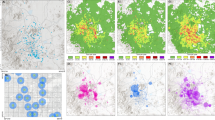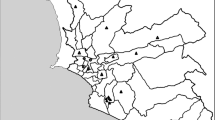Abstract
Background
Preterm birth (PTB) and term low birth weight (LBW) have been associated with pollution and other environmental exposures, but the relationship between these adverse outcomes and specific characteristics of polluted sites is not well studied.
Objectives
We conducted a retrospective cohort study to examine relationships between residential proximity to polluted sites in North Carolina (NC) and PTB and LBW. We further stratified exposure to polluted sites by route of contaminant emissions and specific contaminants released at each site.
Methods
We created an integrated exposure geodatabase of polluted sites in NC from 2002 to 2015 including all landfills, Superfund sites, and industrial sites. Using birth certificates, we assembled a cohort of 1,494,651 singleton births in NC from 2003 to 2015. We geocoded the gestational parent residential address on the birth certificate, and defined exposure to polluted sites as residence within one mile of a site. We used log-binomial regression models to estimate adjusted risk ratios (aRR) and 95% confidence intervals (CI). Binomial models were used to estimate adjusted risk differences (aRD) per 10,000 births and 95% CIs for associations between exposure to polluted sites and PTB or LBW.
Results
We observed weak associations between residential proximity to polluted sites and PTB [aRR(95% CI): 1.07(1.06,1.09); aRD(95% CI): 61(48,74)] and LBW [aRR(95% CI): 1.09(1.06,1.12); aRD(95% CI): 24(17,31)]. Secondary analyses showed increased risk of both PTB and LBW among births exposed to sites characterized by water emissions, air emissions, and land impoundment. In analyses of specific contaminants, increased risk of PTB was associated with proximity to sites containing arsenic, benzene, cadmium, lead, mercury, and polycyclic aromatic hydrocarbons. LBW was associated with exposure to arsenic, benzene, cadmium, lead, and mercury.
Significance
This study provides evidence for potential reproductive health effects of polluted sites, and underscores the importance of accounting for heterogeneity between polluted sites when considering these exposures.
Impact statement
We documented an overall increased risk of both PTB and LBW in births with gestational exposure to polluted sites using a harmonized geodatabase of three site types, and further examined exposures stratified by site characteristics (route of emission, specific contaminants present). We observed increased risk of both PTB and LBW among births exposed to sites with water emissions or air emissions, across site types. Increased risk of PTB was associated with gestational proximity to sites containing arsenic, benzene, cadmium, lead, mercury, and polycyclic aromatic hydrocarbons; increased risk of LBW was associated with exposure to arsenic, benzene, cadmium, lead, and mercury.
This is a preview of subscription content, access via your institution
Access options
Subscribe to this journal
Receive 6 print issues and online access
$259.00 per year
only $43.17 per issue
Buy this article
- Purchase on Springer Link
- Instant access to full article PDF
Prices may be subject to local taxes which are calculated during checkout

Similar content being viewed by others
Data availability
The datasets generated during and/or analyzed during the current study are available from the corresponding author on reasonable request.
References
CDC. Preterm Birth [Internet]. 2020. https://www.cdc.gov/reproductivehealth/maternalinfanthealth/pretermbirth.htm. Accessed 17 Jun 2021.
CDC. Birthweight and Gestation [Internet]. 2021. https://www.cdc.gov/nchs/fastats/birthweight.htm. Accessed 17 Jun 2021.
Martin JA, Hamilton BE, Osterman MJK, Driscoll AK. Births: final data for 2019. Natl Vital- Stat Rep. 2021;70:1–51.
Liu Y, Xu J, Chen D, Sun P, Ma X. The association between air pollution and preterm birth and low birth weight in Guangdong, China. BMC Public Health. 2019;19:3.
Mekonnen ZK, Oehlert JW, Eskenazi B, Shaw GM, Balmes JR, Padula AM. The relationship between air pollutants and maternal socioeconomic factors on preterm birth in California urban counties. J Expo Sci Environ Epidemiol. 2021;31:503–13.
Alman BL, Stingone JA, Yazdy M, Botto LD, Desrosiers TA, Pruitt S, et al. Associations between PM2.5 and risk of preterm birth among liveborn infants. Ann Epidemiol. 2019;39:46–53. e2
Maisonet M, Bush TJ, Correa A, Jaakkola JJ. Relation between ambient air pollution and low birth weight in the Northeastern United States. Environ Health Perspect. 2001;109:351–6.
Ezziane Z. The impact of air pollution on low birth weight and infant mortality. Rev Environ Health. 2013;28:107–15.
Rogers JF, Dunlop AL. Air pollution and very low birth weight infants: a target population? Pediatrics. 2006;118:156–64.
Ferguson KK, O’Neill MS, Meeker JD. Environmental contaminant exposures and preterm birth: a comprehensive review. J Toxicol Environ Health B Crit Rev. 2013;16:69–113.
Sonnenfeld N, Hertz-Picciotto I, Kaye WE. Tetrachloroethylene in drinking water and birth outcomes at the US Marine Corps Base at Camp Lejeune, North Carolina. Am J Epidemiol. 2001;154:902–8.
Ruckart PZ, Bove FJ, Maslia M. Evaluation of contaminated drinking water and preterm birth, small for gestational age, and birth weight at Marine Corps Base Camp Lejeune, North Carolina: a cross-sectional study. Environ Health. 2014;13:99.
Kihal-Talantikite W, Zmirou-Navier D, Padilla C, Deguen S. Systematic literature review of reproductive outcome associated with residential proximity to polluted sites. Int J Health Geogr. 2017;16:20.
Morgan OWC, Vrijheid M, Dolk H. Risk of low birth weight near EUROHAZCON hazardous waste landfill sites in England. Arch Environ Health. 2004;59:149–51.
Goldberg MS, Goulet L, Riberdy H, Bonvalot Y. Low birth weight and preterm births among infants born to women living near a municipal solid waste landfill site in Montreal, Quebec. Environ Res. 1995;69:37–50.
Elliott P, Briggs D, Morris S, de Hoogh C, Hurt C, Jensen TK, et al. Risk of adverse birth outcomes in populations living near landfill sites. BMJ. 2001;323:363–8.
Gilbreath S, Kass PH. Adverse birth outcomes associated with open dumpsites in Alaska Native Villages. Am J Epidemiol. 2006;164:518–28.
Brender JD, Zhan FB, Suarez L, Langlois PH, Moody K. Maternal residential proximity to waste sites and industrial facilities and oral clefts in offspring. J Occup Environ Med. 2006;48:565–72.
Castelló A, Río I, García-Pérez J, Fernández-Navarro P, Waller LA, Clennon JA, et al. Adverse birth outcomes in the vicinity of industrial installations in Spain 2004-2008. Environ Sci Pollut Res Int. 2013;20(Jul):4933–46.
Dodds L, Seviour R. Congenital anomalies and other birth outcomes among infants born to women living near a hazardous waste site in Sydney, Nova Scotia. Can J Public Health. 2001;92:331–4.
Baibergenova A, Kudyakov R, Zdeb M, Carpenter DO. Low birth weight and residential proximity to PCB-contaminated waste sites. Environ Health Perspect. 2003;111:1352–7.
Wagner T. The complete guide to the hazardous waste regulations: RCRA, TSCA, HMTA, OSHA, and Superfund. 3rd ed. New York: JWiley; 1999. xxiv+536.
Agency for Toxic Substances and Disease Registry. TOXICOLOGICAL PROFILE FOR ARSENIC. 2007;559.
Neophytou AM, Kioumourtzoglou MA, Goin DE, Darwin KC, Casey JA. Educational note: addressing special cases of bias that frequently occur in perinatal epidemiology. Int J Epidemiol. 2021;50:337–45.
US EPA O. What is Superfund? [Internet]. US EPA. 2017. https://www.epa.gov/superfund/what-superfund. Accessed 17 Jun 2021.
Centers for Disease Control. Substance Priority List | ATSDR [Internet]. 2020 Accesssed 16 Nov 2021. https://www.atsdr.cdc.gov/spl/index.html.
Agency for Toxic Substances and Disease Registry. Toxicological profile for polycyclic aromatic hydrocarbons. 1995;487.
Brender JD, Suarez L, Langlois PH, Steck M, Zhan FB, Moody K. Are maternal occupation and residential proximity to industrial sources of pollution related? J Occup Environ Med. 2008;50:834–9.
Langlois PH, Brender JD, Suarez L, Zhan FB, Mistry JH, Scheuerle A, et al. Maternal residential proximity to waste sites and industrial facilities and conotruncal heart defects in offspring. Paediatr Perinat Epidemiol. 2009;23:321–31.
Malik S, Schecter A, Caughy M, Fixler DE. Effect of proximity to hazardous waste sites on the development of congenital heart disease. Arch Environ Health: Int J. 2004;59:177–81.
Ward JB, Gartner DR, Keyes KM, Fliss MD, McClure ES, Robinson WR. How do we assess a racial disparity in health? Distribution, interaction, and interpretation in epidemiological studies. Ann Epidemiol. 2019;29:1–7.
Porter TR, Kent ST, Su W, Beck HM, Gohlke JM. Spatiotemporal association between birth outcomes and coke production and steel making facilities in Alabama, USA: a cross-sectional study. Environ Health. 2014;13:85.
Shafran-Nathan R, Yuval, Levy I, Broday DM. Exposure estimation errors to nitrogen oxides on a population scale due to daytime activity away from home. Sci Total Environ. 2017;580:1401–9.
Steinle S, Reis S, Sabel CE. Quantifying human exposure to air pollution–moving from static monitoring to spatio-temporally resolved personal exposure assessment. Sci Total Environ. 2013;443:184–93.
Stanley Emery E III, Eaton A, Grether JK, Nelson KB. Assessment of gestational age using birth certificate data compared with medical record data. Paediatr Perinat Epidemiol. 1997;11:313–21.
Callaghan WM, Dietz PM. Differences in birth weight for gestational age distributions according to the measures used to assign gestational age. Am J Epidemiol. 2010;171:826–36.
Dietz PM, Bombard JM, Hutchings YL, Gauthier JP, Gambatese MA, Ko JY, et al. Validation of obstetric estimate of gestational age on US birth certificates. Am J Obstet Gynecol. 2014;210:335.e1–335.e5.
Goldenberg RL, Culhane JF, Iams JD, Romero R. Epidemiology and causes of preterm birth. Lancet. 2008;371:75–84.
Sanders AP, Desrosiers TA, Warren JL, Herring AH, Enright D, Olshan AF, et al. Association between arsenic, cadmium, manganese, and lead levels in private wells and birth defects prevalence in North Carolina: a semi-ecologic study. BMC Public Health. 2014;14:955.
Alam DS. Prevention of low birthweight. Nestle Nutr Workshop Ser Pediatr Program. 2009;63:209–21. discussion 221-225, 259–68
Ashton DM, Lawrence HC, Adams NL, Fleischman AR. Surgeon general’s conference on the prevention of preterm birth. Obstet Gynecol. 2009;113:925–30.
Institute of Medicine. Preterm birth: causes, consequences, and prevention [Internet]. Washington, DC: The National Academies Press; 2007. https://www.nap.edu/catalog/11622/preterm-birth-causes-consequences-and-prevention.
Acknowledgements
The authors would like to acknowledge the two EPA technical reviewers who read this manuscript and provided helpful feedback. CK was supported in part by training grant from the National Institute of Environmental Health Sciences [T32ES007018].
Author information
Authors and Affiliations
Contributions
CK, TD, and AO conceived and designed the study. NF and TL developed the administrative cohort and specified relevant covariate and outcome variables. CK conducted the analysis. CK, TD, AO, and TL interpreted the results. CK prepared the draft manuscript. TD, AO, TL, and NF reviewed the manuscript and provided substantial feedback. All authors reviewed the results and approved the final version of the manuscript.
Corresponding author
Ethics declarations
Competing interests
The authors declare no competing interests.
Ethical approval
This study protocol was approved by the Institutional Review Boards of the University of North Carolina at Chapel Hill UNC (IRB Number: 09-0828) and the NC Division of Public Health. The EPA’s Human Subjects Research Officer also reviewed and approved this work (HSR-001254).
Additional information
Publisher’s note Springer Nature remains neutral with regard to jurisdictional claims in published maps and institutional affiliations.
Supplementary information
Rights and permissions
Springer Nature or its licensor holds exclusive rights to this article under a publishing agreement with the author(s) or other rightsholder(s); author self-archiving of the accepted manuscript version of this article is solely governed by the terms of such publishing agreement and applicable law.
About this article
Cite this article
Keeler, C., Luben, T.J., Forestieri, N. et al. Is residential proximity to polluted sites during pregnancy associated with preterm birth or low birth weight? Results from an integrated exposure database in North Carolina (2003–2015). J Expo Sci Environ Epidemiol 33, 229–236 (2023). https://doi.org/10.1038/s41370-022-00475-0
Received:
Revised:
Accepted:
Published:
Issue Date:
DOI: https://doi.org/10.1038/s41370-022-00475-0



